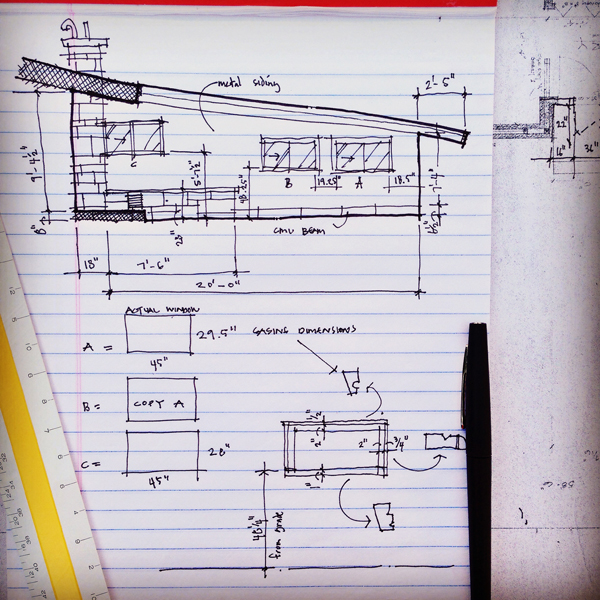Whenever an architect sits down with a new client on a new residential project, the first thing that happens is a conversation about project goals and requirements. It is during this initial conversation that everyone tries to figure out what exactly it is that this project is supposed to accomplish (keeping the rain out is generally assumed and isn’t the sort of question I am talking about).
This phase of the work is widely referred to as “Schematic Design”. Although some people also have an earlier phase called “Programming”, I tend to consider that as part of the schematic design phase as well, rather than separate it out into its own special section.
“Sorry, Programming … you just aren’t that special.”
(that sounds like something Schematic Design would say to Programming if it were a jerk.)

I just returned from an initial schematic design and programming meeting with some new clients, and I’ll be honest, it wasn’t like any initial meeting I have ever had.
It was way better. We had meetings around a picnic table, on a dock while people were swimming, while people were fishing … and beer might have been involved during all of those meetings. When the meetings first began, most of the conversation was centered around renovating and doing an addition to a house that has been in the family around 30+ years. As a result, I spent half of one day documenting the existing conditions in the house. There were original construction drawings available but it became obvious that those drawings didn’t reflect what was actually built (imagine that) … The finished constructed house just reflected the “essence” of those architectural drawings.

So as I measured existing conditions, the family watched me working as they grilled bratwurst for lunch, they did a little fishing … maybe even a nap might have been involved at one time or another. There was definitely a hammock being used … and not just by me.

(this is a view from the dock … pretty nice office to work in for a few days)

In the end, we concluded that there will be a new house built. The point of this post is to talk about the process of programming and schematic design. I have pages and pages of notes where we talked about the number of bedrooms, kitchen, living area, outside cooking needs, etc. During this conversation, I had my notepad out as well as my trusty roll of trace paper (don’t know what tracing paper is? Go here and look at #2, you can even find out where to buy it).
As we are talking, I would ask questions and draw diagrams right in front of the clients to make sure we were on the same page. What was pretty cool was that my pen started being passed around the table as everyone started to get in on the sketching action. As I was drawing, I kept saying “This isn’t architecture … this is a diagram. Your house will not look like this.”
Although, it did look a little like architecture.

Tracing paper isn’t precious and I have no problems wasting it by the yard. After our last programming and schematic design session, I came back to the office with an armload of diagrams that everyone at the table was a party to making. We all know – at this point – what rooms are desired, where they need to be located, the required adjacencies to surrounding spaces. It was an extremely productive design session, far better than if I had simply asked questions and taken notes.
… and again, beer might have been involved in this meeting as well.

I’ve said it on many occasions, I am just “okay” at sketching but I am able to get my point across in real-time. The fact that these clients jumped right in and started sketching along with me lets me know that this was a good idea. In the sketch above, we were talking about the master bathroom, and it was during that conversation that I shared with them the story of my own ridiculous master bathroom shower (infamously covered here: ‘An Architect’s House – Master Shower” and here: “Master Bath Shower – You Displease Me” Both articles are in the Life of an Architect ‘Hall of Fame’) You can see the floor plan of my shower sketched up above – to scale no doubt.

In the end, we developed a programming and schematic design bubble diagram, that in concert with my notes, paints a pretty clear picture of rooms, adjacencies, spatial relationship, site orientation, vehicular access, etc. etc.
Now that I am back at my desk, I am able to take that information and use it to prepare a more formal document that will list the rooms and their proposed sizes so that we can start to evaluate total estimated square footage for the project. I’ll also be addressing the other aspects of schematic design that take place during this phase – zoning requirements (specifically setbacks from surrounding properties and from the water’s edge), preliminary budget evaluation, possible materials, and conversations with the proposed contractor to make sure we are all on the same page and I work with products and materials to which he will have access.
The schematic design (and programming) phase is one of my favorites because there is such a social aspect to the collection of the material needed to do a proper job. It’s important that I have a real working understanding of how the house will ultimately be used so that we can create a finished product that supports this family’s lifestyle. I now know that he likes to fish, their daughter likes to read, and she likes to take photos of the surrounding wildlife.
… and now they know that I like to drink beer and tell stories. Speaking of stories, remind me to tell you the “Prison Toilet” story.
Cheers,

